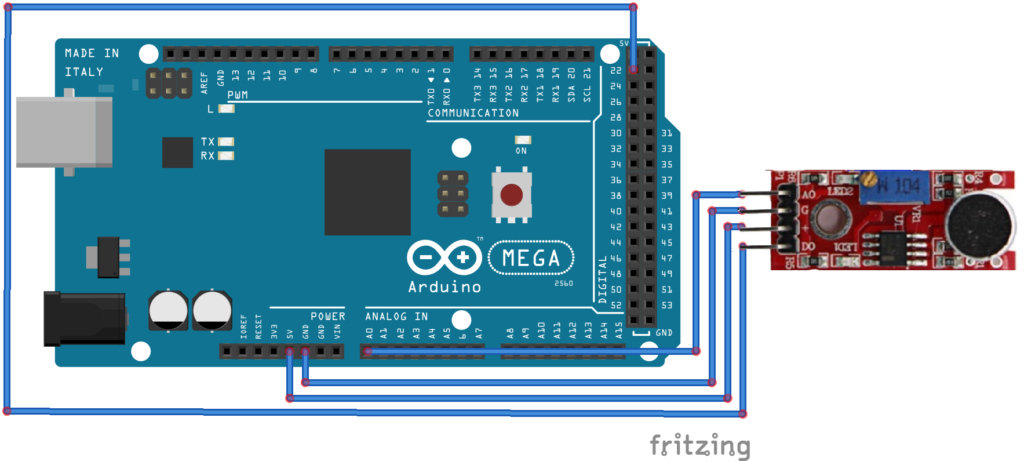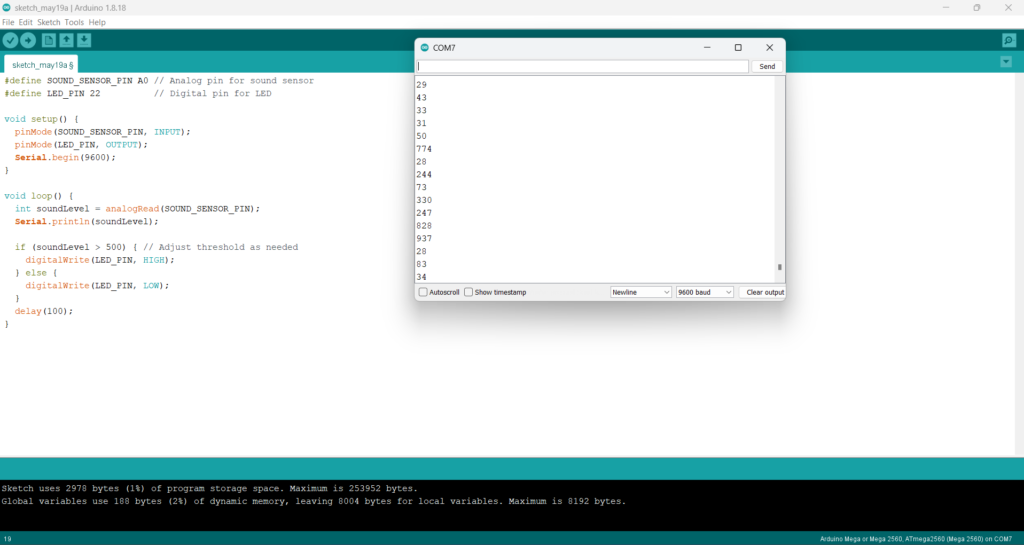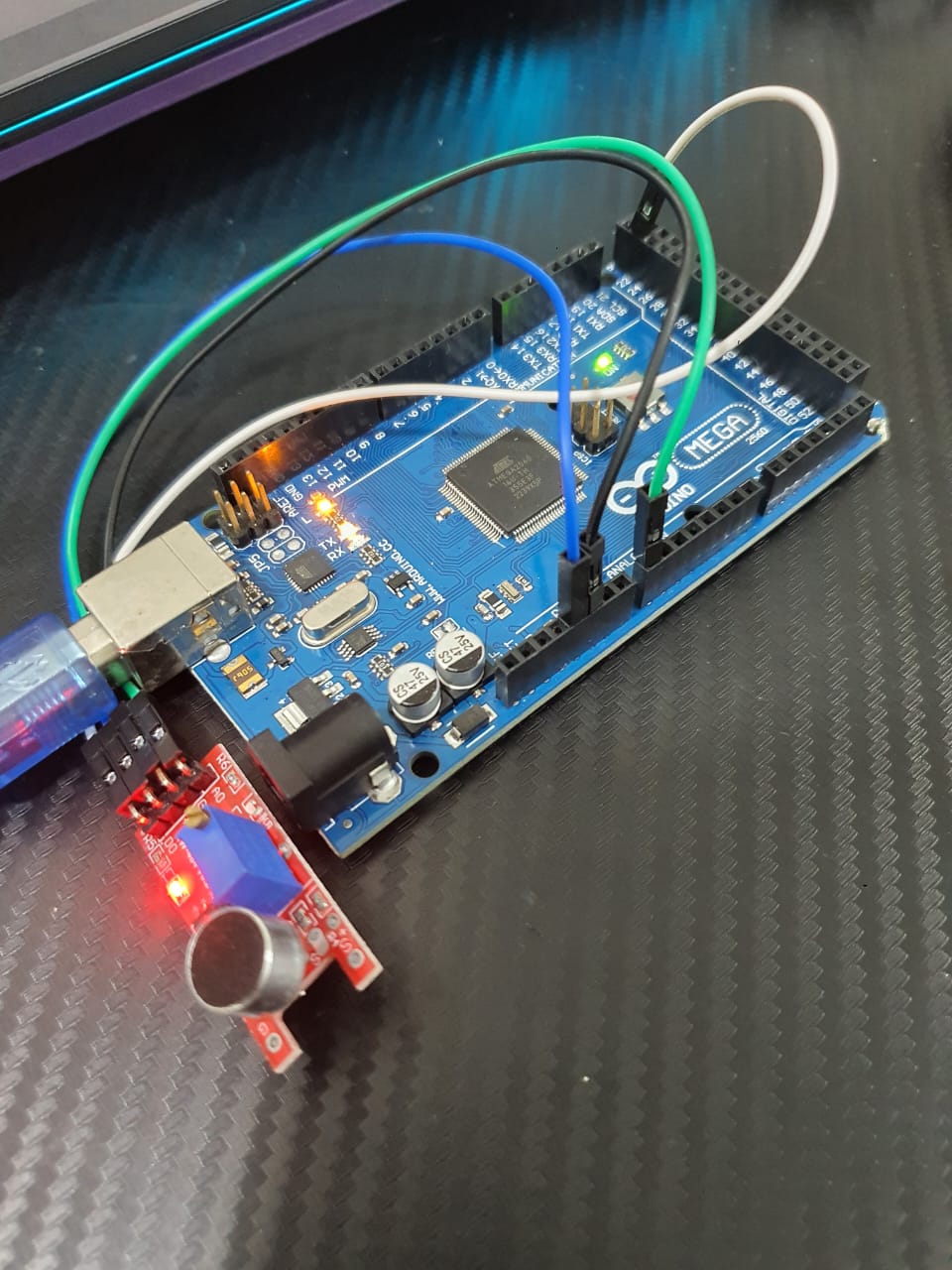The KY-037 Microphone Sound Sensor is a module designed to detect sound levels and convert them into electrical signals that can be read by a microcontroller or other digital device. It is particularly sensitive and can detect even subtle changes in sound levels, making it useful for various applications such as sound-activated switches, voice-activated devices, sound monitoring systems, and more.
Features of KY-037 Microphone Sound Sensor:
- High Sensitivity: The sensor is designed to detect sound waves with high sensitivity, making it suitable for detecting a wide range of sound levels.
- Adjustable Sensitivity: Some versions of the sensor come with a potentiometer that allows you to adjust the sensitivity level according to your requirements.
- Analog Output: The sensor provides an analog output signal proportional to the sound level it detects. This analog signal can be read by an analog-to-digital converter (ADC) on a microcontroller.
- Digital Output: In addition to the analog output, the sensor may also provide a digital output signal that indicates whether a sound threshold has been crossed. This signal is useful for triggering actions based on sound detection.
- Simple Interface: The sensor typically has few pins and can be easily interfaced with microcontrollers using analog or digital input pins.
- Wide Voltage Range: The sensor usually operates over a wide voltage range, making it compatible with various microcontroller boards and power sources.
Connection and Pinout:

The KY-037 Microphone Sound Sensor module typically has the following pinout:
- AO (Analog Output): This pin provides the analog output voltage proportional to the sound level detected by the sensor. It can be connected to an analog input pin of a microcontroller
- DO (Digital Output): This pin provides a digital output signal (usually TTL logic level) that indicates whether a sound threshold has been crossed. It can be connected to a digital input pin of a microcontroller.
- GND (Ground): Connect this pin to the ground (GND) of the power source.
- VCC: This pin is connected to the positive supply voltage (VCC) typically ranging from 3.3V to 5V.
KY-037 Microphone Sound Sensor Usage:
To use the KY-037 Microphone Sound Sensor, follow these general steps:
- Power Supply: Connect the VCC pin to a suitable power source (3.3V to 5V) and GND pin to the ground.
- Analog Output: If you want to measure sound levels using analog voltage, connect the AO pin to an analog input pin of your microcontroller.
- Digital Output (Optional): If you want to detect sound threshold crossings, connect the DO pin to a digital input pin of your microcontroller.
- Sensitivity Adjustment (Optional): If your sensor module has a sensitivity adjustment potentiometer, you can adjust it to fine-tune the sensitivity according to your application requirements.
- Programming: Write a program for your microcontroller to read the analog or digital output of the sensor and take appropriate actions based on the sound levels detected.
Circuit Diagram:

Example Coding:
Here’s a simple example of how you might use the KY-037 Microphone Sound Sensor with an Arduino to turn an LED on when a loud sound is detected:
#define SOUND_SENSOR_PIN A0 // Analog pin for sound sensor
#define LED_PIN 22 // Digital pin for LED
void setup() {
pinMode(SOUND_SENSOR_PIN, INPUT);
pinMode(LED_PIN, OUTPUT);
Serial.begin(9600);
}
void loop() {
int soundLevel = analogRead(SOUND_SENSOR_PIN);
Serial.println(soundLevel);
if (soundLevel > 500) { // Adjust threshold as needed
digitalWrite(LED_PIN, HIGH);
} else {
digitalWrite(LED_PIN, LOW);
}
delay(100);
}The KY-037 Microphone Sound Sensor, with its high sensitivity to sound, finds applications in various projects that require detection and analysis of audio signals. Here are some common applications:

KY-037 Microphone Sound Sensor Application
1. Sound-Activated Switch:
Use the KY-037 to control devices or circuits based on sound levels. For example:
- Turn on lights or appliances when a loud sound is detected.
- Trigger a camera or recording device in response to a specific sound.
- Activate alarms or security systems upon detecting suspicious noises.
2. Voice-Activated Devices:
Integrate the KY-037 into voice-controlled systems for hands-free operation:
- Voice-controlled home automation systems to control lights, fans, and other appliances.
- Voice-activated assistants or smart speakers for performing tasks like setting reminders, playing music, or fetching information.
3. Noise Monitoring:
Deploy the KY-037 to monitor environmental noise levels:
- Noise pollution monitoring systems in urban areas to measure traffic noise, construction activities, etc.
- Sound level meters for workplace safety compliance to monitor noise levels in factories or industrial settings.
4. Interactive Installations:
Incorporate the KY-037 into interactive art installations or exhibits:
- Sound-reactive installations that change colors, patterns, or visuals based on ambient sound levels.
- Interactive games or exhibits where sound input from users triggers various responses or actions.
5. Musical Instruments:
Use the KY-037 to create interactive musical instruments or controllers:
- Sound-based synthesizers or sequencers where sound inputs trigger musical notes or sequences.
- Drum pads or triggers for electronic drum kits that respond to drum hits or percussive sounds.
6. Voice Recognition Systems:
Integrate the KY-037 as part of a voice recognition or speech processing system:
- Voice-controlled door locks or access control systems for secure entry.
- Voice authentication systems for personal devices or applications.
7. Baby Monitoring:
Employ the KY-037 for monitoring and responding to sounds in baby monitoring systems:
- Sound-activated baby monitors that alert caregivers when the baby cries or makes noise.
- Monitoring systems with features like temperature sensing and lullaby playback.
8. Audio Visualization:
Create visualizations or animations that respond to sound inputs using the KY-037:
- LED matrix displays or light sculptures that change patterns or colors based on music or ambient sounds.
- Audio-reactive animations or graphics in multimedia installations or performances.
9. Education and Learning:
Utilize the KY-037 in educational projects to teach concepts related to sound and electronics:
- Science fair projects demonstrating sound wave properties, amplitude, frequency, etc.
- Hands-on learning activities to explore sound engineering and signal processing concepts.
10. Health Monitoring:
Integrate the KY-037 into healthcare devices or wearables for monitoring physiological signals:
- Sound-based respiratory rate monitors that analyze breathing sounds for respiratory health assessment.
- Sleep monitoring systems that analyze snoring patterns or other sleep-related sounds for sleep quality assessment.
These applications demonstrate the versatility of the KY-037 Microphone Sound Sensor and its potential to enhance various projects across different domains, from home automation and entertainment to healthcare and education. Its high sensitivity and ease of use make it a valuable component for sound detection and analysis in diverse applications.
Conclusion:
The KY-037 Microphone Sound Sensor is a versatile module with high sensitivity, suitable for detecting sound levels in various applications. By interfacing it with a microcontroller, you can create sound-activated systems, noise monitoring devices, and other projects that respond to sound stimuli. Understanding its features, pinout, and usage can help you effectively incorporate it into your projects.
Expertise on Engineering.
Robotic and microcontroller are like toys to me.
I love playing with them.
